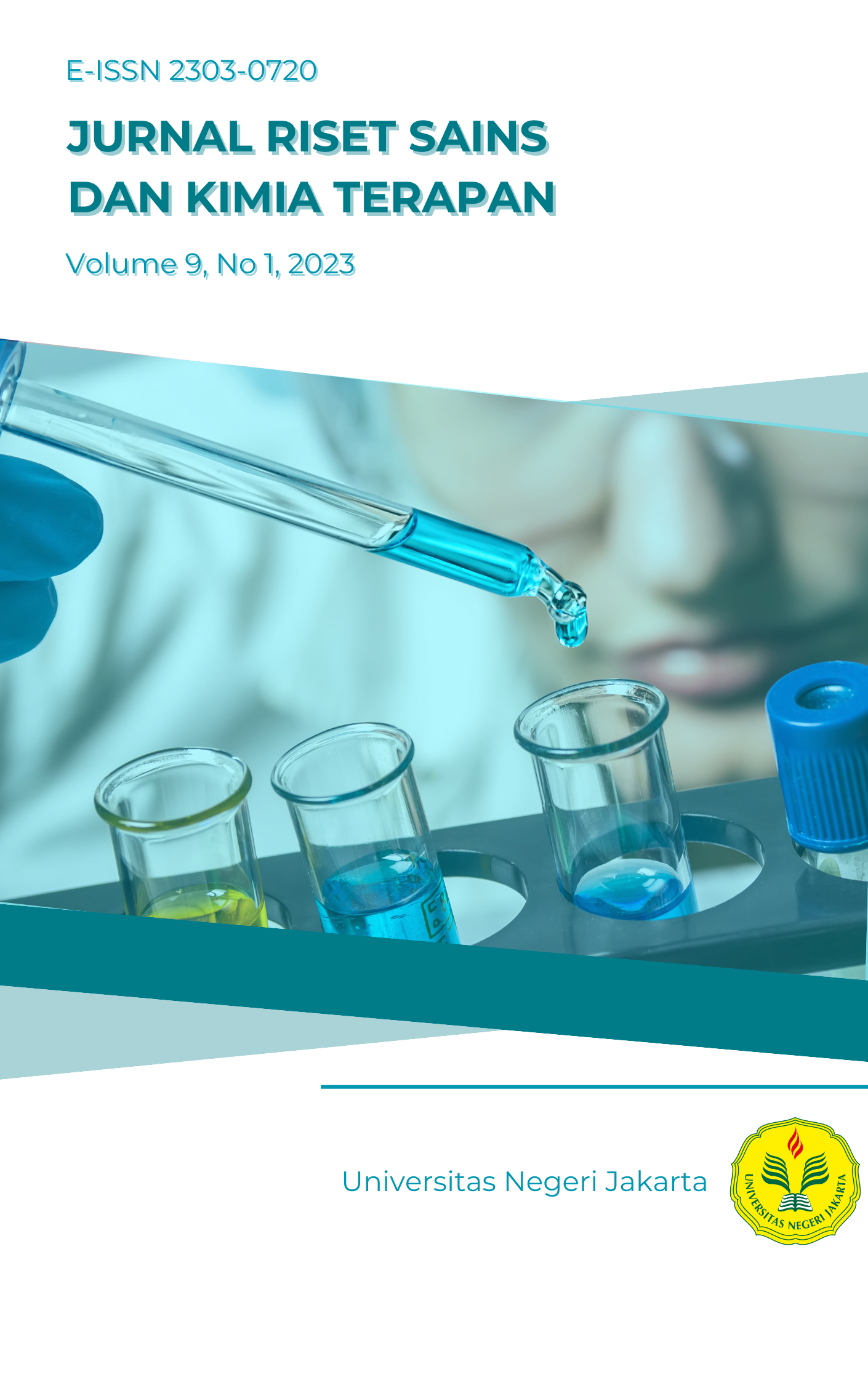Analisis Kandungan Residu Pestisida pada Cabai dan Kentang menggunakan Liquid Chromatography Tandem Mass Spectrometry (LC-MS/MS)
DOI:
https://doi.org/10.21009/JRSKT.101.04Keywords:
LC-MS/MS, residu pestisida, QuEChERSAbstract
Abstrak
Pestisida dalam pertanian merupakan hal yang umum digunakan oleh petani dalam mengendalikan hama dan penyakit tanaman. Namun, penggunaan pestisida berlebihan akan meninggalkan residu pestisida dalam jumlah besar yang dapat menimbulkan masalah kesehatan. Oleh karena itu, perlunya pengujian kadar residu pestisida (chlorpyrifos, diazinon dan dimethoate) pada cabai dan kentang yang mengacu pada nilai batas maksimum cemaran berdasarkan PERMENTAN Nomor 53 Tahun 2018. Pengujian dilakukan dengan metode QuEChERS EN 15662:2018 yang terdiri dari tahapan ekstraksi dan clean-up dengan penetapan kadar menggunakan LC-MS/MS. Hasil pengujian menunjukkan kadar residu pestisida chlorpyrifos, diazinon dan dimethoate dalam cabai dan kentang berada di bawah Batas Maksimum Residu yang telah ditetapkan oleh PERMENTAN Nomor 53 Tahun 2018 sehingga aman untuk dikonsumsi.
Kata kunci: LC-MS/MS, residu pestisida, QuEChERS
Abstract
Farmers frequently use pesticides in agriculture to control pests and plant diseases. However, excessive use of pesticides will leave large amounts of pesticide residue, which can cause health problems. Therefore, it is necessary to test pesticide residue levels (chlorpyrifos, diazinon, and dimethoate) on chilies and potatoes, which refers to the maximum limit value of contamination based on PERMENTAN Number 53 of 2018. The QuEChERS EN 15662:2018 method is used for the test. It has stages for extraction, clean-up, and an assay using LC-MS/MS. The test results demonstrate that chilies and potatoes do not contain pesticides chlorpyrifos, diazinon, or dimethoate above Permentan Number 53 of the 2018 Maximum Residue Limit. This result means that foods are safe to eat.
Keywords: LC-MS/MS, pesticide residues, QuEChERS
References
Araújo, M. F., Castanheira, E. M. S., & Sousa, S. F. (2023). The Buzz on Insecticides: A Review of Uses, Molecular Structures, Targets, Adverse Effects, and Alternatives. Molecules, 28(8), 3641. https://doi.org/10.3390/molecules28083641
Bal, S., Sharangi, A. B., Upadhyay, T. K., Khan, F., Pandey, P., Siddiqui, S., Saeed, M., Lee, H.-J., & Yadav, D. K. (2022). Biomedical and Antioxidant Potentialities in Chilli: Perspectives and Way Forward. Molecules, 27(19), 6380. https://doi.org/10.3390/molecules27196380
Beane Freeman, L. E. (2022). Invited Perspective: Pesticide Adjuvants and Inert Ingredients — A Missing Piece of the Puzzle. Environmental Health Perspectives, 130(8). https://doi.org/10.1289/ehp11512
Dessie, A. B., Koye, T. D., Koye, A. D., & Abitew, A. A. (2019). Analysis of red pepper marketing: evidence from northwest Ethiopia. Journal of Economic Structures, 8(1). https://doi.org/10.1186/s40008-019-0156-0
El-Sheikh, E.-S. A., Li, D., Hamed, I., Ashour, M.-B., & Hammock, B. D. (2023). Residue Analysis and Risk Exposure Assessment of Multiple Pesticides in Tomato and Strawberry and Their Products from Markets. Foods, 12(10), 1936. https://doi.org/10.3390/foods12101936
Gori, M., Thakur, A., Sharma, A., & Flora, S. J. S. (2021). Organic-Molecule-Based Fluorescent Chemosensor for Nerve Agents and Organophosphorus Pesticides. Topics in Current Chemistry, 379(5). https://doi.org/10.1007/s41061-021-00345-7
Gupta, U. C., & Gupta, S. C. (2019). The Important Role of Potatoes, An Underrated Vegetable Food Crop in Human Health and Nutrition. Current Nutrition & Food Science, 15(1), 11–19. https://doi.org/10.2174/1573401314666180906113417
Huynh, T., Tran, L., & Dao, S. (2020). Real-Time Size and Mass Estimation of Slender Axi-Symmetric Fruit/Vegetable Using a Single Top View Image. Sensors, 20(18), 5406. https://doi.org/10.3390/s20185406
Jha, G. K., Suresh, A., Punera, B., & Supriya, P. (2019). Growth of horticulture sector in India: Trends and prospects. The Indian Journal of Agricultural Sciences, 89(2). https://doi.org/10.56093/ijas.v89i2.87091
Johnson, C. M., & Cheein, F. A. (2023). Machinery for potato harvesting: a state-of-the-art review. Frontiers in Plant Science, 14. https://doi.org/10.3389/fpls.2023.1156734
Keklik, M., Golge, O., González-Curbelo, M. Á., & Kabak, B. (2024). Determination of Pesticide Residues in Vine Leaves Using the QuEChERS Method and Liquid Chromatography-Tandem Mass Spectrometry. Foods, 13(6), 909–909. https://doi.org/10.3390/foods13060909
Khattabi, L., Mokhtari, M., Bouhenna, M. M., Fellak, A., Abu-Mustapha, M., Akkal, S., & SalehSellam, S. (2023). Agricultural and Veterinary Pesticides Residues in Human Food. Current Green Chemistry, 10(2), 174–185. https://doi.org/10.2174/2213346110666230607150014
Mali, H., Shah, C., Raghunandan, B. H., Prajapati, A. S., Patel, D. H., Trivedi, U., & Subramanian, R. B. (2022). Organophosphate pesticides an emerging environmental contaminant: Pollution, toxicity, bioremediation progress, and remaining challenges. Journal of Environmental Sciences, 127. https://doi.org/10.1016/j.jes.2022.04.023
Mishra, T., Raigond, P., Thakur, N., Dutt, S., & Singh, B. (2020). Recent Updates on Healthy Phytoconstituents in Potato: a Nutritional Depository. Potato Research, 63(3), 323–343. https://doi.org/10.1007/s11540-019-09442-z
Oyoo‐Ilukol, J., Abong, G. O., Okoth, M. W., & Nyongesa, M. W. (2023). Analysis of pesticide residues in potato varieties using modified quechers multi‐residue method combined with gas chromatography tandem mass spectrometric detection. Crop Science, 64(3), 1399–1411. https://doi.org/10.1002/csc2.21121
Sharma, S., Katoch, V., Kumar, S., & Chatterjee, S. (2021). Functional relationship of vegetable colors and bioactive compounds: Implications in human health. The Journal of Nutritional Biochemistry, 92, 108615. https://doi.org/10.1016/j.jnutbio.2021.108615
Shrestha, S., Lamichhane, B., & Chaudhary, N. (2024). Method Validation and Measurement Uncertainty Estimation for Determination of Multiclass Pesticide Residues in Tomato by Liquid Chromatography-Tandem Mass Spectrometry (LC-MS/MS). International Journal of Analytical Chemistry, 2024(1), 1–10. https://doi.org/10.1155/2024/3846392
Sinha, S. N., Kumpati, R. K., Ramavath, P. N., Sangaraju, R., Gouda, B., & Chougule, P. (2022). Investigation of acute organophosphate poisoning in humans based on sociodemographic and role of neurotransmitters with survival study in South India. Scientific Reports, 12(1). https://doi.org/10.1038/s41598-022-21054-1
Sugiyanta, S., & Kartika, J. G. (2018). Increasing Production of Chilli (Capsicum annuum L.) through Foliar Fertilizer Application. Journal of Tropical Crop Science, 5(1), 18–24. https://doi.org/10.29244/jtcs.5.1.18-24
Tomlekova, N., Mladenov, P., Dincheva, I., & Nacheva, E. (2022). Metabolic Profiling of Bulgarian Potato Cultivars. Foods, 11(13), 1981. https://doi.org/10.3390/foods11131981
Wahab, S., Muzammil, K., Nasir, N., Khan, M. S., Ahmad, M. F., Khalid, M., Ahmad, W., Dawria, A., Reddy, L. K. V., & Busayli, A. M. (2022). Advancement and New Trends in Analysis of Pesticide Residues in Food: A Comprehensive Review. Plants, 11(9), 1106. https://doi.org/10.3390/plants11091106
Wang, S., Xu, T., & Li, X. (2022). Development Status and Perspectives of Crop Protection Machinery and Techniques for Vegetables. Horticulturae, 8(2), 166–166. https://doi.org/10.3390/horticulturae8020166
Xu, J., Li, Y., Kaur, L., Singh, J., & Zeng, F. (2023). Functional Food Based on Potato. Foods, 12(11), 2145–2145. https://doi.org/10.3390/foods12112145







